Reviewing the UK’s Action Levels for the Management of Dredged Material
Abstract
:1. Introduction
- Reviewing the current AL2 (and potentially the current AL1 in parallel) as the UK current AL2s are the least protective of the marine environment within the OSPAR nations, whilst considering the burden it would place on industry;
- Reviewing the current ALs using UK specific sediments;
- Providing an initial analysis of how updating ALs could impact the port industry.
2. Materials and Methods
2.1. Data Collection
2.2. Data Rationalisation and Validation
2.3. Data Scenario Selection
2.4. Data Assessment Metrics
2.4.1. Below Action Level 1
2.4.2. Above AL2
2.4.3. Range of Values
3. Results
3.1. Current Action Levels
3.2. Trace Metals
3.2.1. Revised Action Levels
3.2.2. Regional Trace Metal Action Level 1s
3.3. Organotins
3.3.1. Revised Action Levels
3.3.2. Proposed Scenarios
3.4. Polycyclic Aromatic Hydrocarbons (PAHs)
3.4.1. Revised Action Levels
3.4.2. Proposed Scenarios
3.5. Polychlorinated Biphenyls (PCBs)
3.5.1. Revised Action Levels
3.5.2. Proposed Scenarios
3.6. Organochlorine Pesticides (OCPs)
3.6.1. Revised Action Levels
3.6.2. Proposed Scenarios
3.7. Polybrominated Diphenyl Ethers (PBDEs)
3.7.1. Revised Action Levels
3.7.2. Proposed Scenarios
4. Discussion
4.1. Trace Metals
4.2. Organotins
4.3. Polycyclic Aromatic Hydrocarbons (PAHs)
4.4. Polychlorinated Biphenyls (PCBs)
4.5. Organochlorine Pesticides (OCPs)
4.6. Polybrominated Diphenyl Ethers (PBDEs)
4.7. Emerging Contaminants
4.8. Implications
- Trace Metals. Consider adopting the revised ALs [7] and introducing background-based port AL1s. Application of background-based port AL1s beyond England would need to be considered by the devolved administrations. While the revised AL2s address the concerns raised in the ‘High Level Review’ [6] to some extent, they will still be either higher or equally the highest by comparison with other OSPAR countries with comparable AL2s (i.e., those analysing the <2 mm sediment fraction). Consequently, it would be prudent to review the trace metal AL2s further in due course. In addition, it would also be prudent to review the ALs where the potential inputs of certain trace metals are linked to emerging concerns (e.g., nanoparticles).
- Organotins. Consider adopting the revised ALs [7].
- Polycyclic Aromatic Hydrocarbons (PAHs). There are no current ALs, and all scenarios will therefore have the potential to cause additional burdens. The adoption of summed PAHs for LMW and HMW should be considered and new thresholds should be based on ERL/ERMs [15]. The introduction of the proposed ALs is likely to require either a phased approach where the implementation of proposed ALs is staggered to allow ports time to adjust to the management of dredging or a regional approach, particularly in Northumbria and the Humber. THC is highly limited and should not be proposed as a future AL.
- Polychlorinated biphenyls (PCBs). Revised ALs [7] for Σ25_PCBs and the phasing in of individual PCB ALs should be considered, as concentrations are still relatively high in the marine environment due to the persistent nature of these contaminants.
- Organochlorine Pesticides (OCPs). There are only two current ALs for OCPs (Dieldrin and dichlorodiphenyltrichloroethane (DDT)). No revised ALs. No changes to the current ALs proposed are generally known to have been reduced in the environment.
- Polybrominated diphenyl ethers (PBDEs). There are no current ALs for PBDEs. Minimal data are available. PBDEs are known to be a concern in the marine environment. Proposed ALs are based on FESG (Canadian Federal Environmental Sediment Guidelines as used for OSPAR MIME assessments) [19]. PBDEs ALs with analyses only should be requested if flagged as a high-risk area/ known area of concern or in relation to an incident. It is proposed that a baseline study would be useful to make sure any high-risk areas are not being missed.
- To maintain and update the collated dataset to help understand and sense check new applications.
- Other factors for future consideration highlighted include:
- To include water quality criteria.
- To keep abreast of new methods in assessing the environment, for example, passive sampling, which may become more dominant than direct testing and ensure the use of new methods and ALs are compatible.
- To identify high risk areas for emerging contaminants, including plastics, in dredge areas around the UK.
- To consider incorporating bioassays and ecotoxicology into the assessment framework and providing specific guidance on when it should be used, as currently UK use is limited.
- To consider introducing requirements for the measurements of black carbon and particulate organic carbon analyses in support of the interpretation of polycyclic aromatic hydrocarbons (PAHs).
- To improve understanding on how measuring uncertainty as a result of a wider range of laboratories as well as some difference in methodologies are now providing data for assessments since the ‘High Level Review’ [6] are now providing data for assessments.
5. Conclusions
6. Patents
Author Contributions
Funding
Institutional Review Board Statement
Informed Consent Statement
Data Availability Statement
Acknowledgments
Conflicts of Interest
References
- DEFRA. Safeguarding Our Seas. 2011; 82p. Available online: https://www.gov.uk/government/publications/safeguarding-our-seas (accessed on 15 September 2021).
- Bolam, S.G.; Rees, H.L.; Somerfield, P.; Smith, R.; Clarke, K.R.; Warwick, R.M.; Atkins, M.; Garnacho, E. Ecological consequences of dredged material disposal in the marine environment: A holistic assessment of activities around the England and Wales coastline. Mar. Pollut. Bull. 2006, 52, 415–426. [Google Scholar] [CrossRef] [PubMed]
- Gupta, A.K.; Gupta, S.K.; Patil, R.S. Environmental management plan for port and harbour projects. Clean Technol. Environ. Policy 2005, 7, 133–141. [Google Scholar] [CrossRef]
- International Maritime Organisation (IMO). Waste Assessment Guidelines under the London Convention and Protocol; IMO: London, UK, 2014; ISBN 978-92-801-1613-7. [Google Scholar]
- OSPAR. Guidelines for the Management of Dredged Material at Sea. 2014. Available online: https://www.ospar.org/documents?d=34060 (accessed on 21 October 2021).
- Marine Management Organisation (MMO). High Level Review of Current UK Action Level Guidance. A Report Produced for the Marine Management Organisation; MMO Project No: 1053; Marine Management Organisation (MMO): Newcastle, UK, 2015; 73p, ISBN 978-1-909452-350. [Google Scholar]
- Defra. The Use of Action Levels in The Assessment of Dredged Material Placement at Sea and in Estuarine Areas under FEPA (II) (The Revised Actions Levels), Defra Project Code AE0258. 12p. Available online: http://randd.defra.gov.uk/Default.aspx?Module=More&Location=None&ProjectID=9962 (accessed on 21 October 2021).
- OSPAR. Overview of Contracting Parties’ National Action Levels for Dredged Material (2008 Update). Available online: https://www.ospar.org/documents?v=7113 (accessed on 21 October 2021).
- Defra. Background Levels and the Anthropogenic Component, of Naturally Occurring Elements in Marine Sediments Subject to Dredging and Disposal; Report to Defra Project AE0257; Centre for Environment, Fisheries and Aquaculture Science: Lowestoft, UK, 2003; 15p. Available online: http://randd.defra.gov.uk/Default.aspx?Menu=Menu&Module=More&Location=None&Completed=0&ProjectID=9102#RelatedDocuments (accessed on 21 October 2021).
- MMO Public Register. Available online: https://marinelicensing.marinemanagement.org.uk/mmofox5/fox/live/MMO_PUBLIC_REGISTER/ (accessed on 15 September 2021).
- Bolam, T.; Barry, J.; Law, R.J.; James, D.; Thomas, B.; Bolam, S.G. A temporal and spatial assessment of TBT concentrations at dredged material disposal sites around the coast of England and Wales. Mar. Pollut. Bull. 2014, 79, 326–332. [Google Scholar] [CrossRef] [PubMed]
- International Council for the Exploration of the Sea (ICES). Report of the Advisory Committee on Marine Pollution. ICES Cooperative Research Reports. 1990. No. 172. Available online: https://www.ices.dk/sites/pub/Publication%20Reports/Forms/DispForm.aspx?ID=37424 (accessed on 21 October 2021).
- Mason, C.; Lonsdale, J.; Vivian, C.; Griffith, A.; Warford, L.; Hynes, C.; Barber, J.; Sheahan, D.; Bersuder, P.; Bakir, A. Review of Action Levels Used for Assessing Dredging and Disposal Marine Licences; Report ME5226/C7590; Department of the Environment, Food and Rural Affairs: London, UK, 2020; 113p. [Google Scholar]
- Woodhead, R.J.; Law, R.J.; Matthiessen, P. Polycyclic aromatic hydrocarbons (PAH) in surface sediments around England and Wales, and their possible biological significance. Mar. Pollut. Bull. 1999, 38, 773–790. [Google Scholar] [CrossRef]
- Gorham-Test, C.; Wade, T.; Engle, V.; Summers, K.; Hornig, E. Regional Environmental Monitoring and Assessment Program—Galveston Bay 1993. In Proceedings of the Galveston Bay Estuary Program, State of the Bay Symposium IV, Galveston, TX, USA, 28–29 January 1999; pp. 97–109. [Google Scholar]
- CCME. Canadian Sediment Quality Guidelines for the Protection of Aquatic Life: Polycyclic Aromatic Hydrocarbons (PAHs). In Canadian Environmental Quality Guidelines; Canadian Council of Ministers of the Environment: Winnipeg, MB, Canada, 1999; Available online: https://ccme.ca/en/res/polycyclic-aromatic-hydrocarbons-pahs-canadian-sediment-quality-guidelines-for-the-protection-of-aquatic-life-en.pdf (accessed on 15 September 2021).
- International Maritime Organisation (IMO). Waste Assessment Guidance: Development of default lists and action levels for dredged material. In Proceedings of the International Maritime Organization, Scientific Group of the London Convention—41st Meeting and Scientific Group of the London Protocol—12th Meeting, London, UK, 30 April–4 May 2018. [Google Scholar]
- OSPAR (2019 Update) Audit Trail of OSPAR EACs and Other Assessment Criteria Used to Distinguish above and below Thresholds. 2020. Available online: https://www.ospar.org/documents?v=43066 (accessed on 15 September 2021).
- Government of Canada Federal Environmental Quality Guidelines (FEQGs). 2013. Available online: https://www.ec.gc.ca/ese-ees/default.asp?lang=En&n=05DF7A37-1 (accessed on 15 September 2021).
- OSPAR Background Document for Canadian Federal Environmental Quality Guidelines (FEQGs) for Polybrominated Diphenyl Ethers (PBDEs) in Sediment and Biota. 2020. Available online: https://www.ospar.org/documents?v=42746 (accessed on 16 September 2021).
- Commission Regulation EC 552/2009. Available online: http://data.europa.eu/eli/reg/2009/552/oj (accessed on 16 September 2021).
- Brack, W.; Ait-Aissa, S.; Burgess, R.M.; Busch, W.; Creusot, N.; Di Paolo, C.; Escher, B.I.; Hewitt, L.M.; Hilscherova, K.; Hollender, J.; et al. Effect-directed analysis supporting monitoring of aquatic environments—an in-depth overview. Sci. Total Environ. 2016, 544, 1073–1118. [Google Scholar] [CrossRef] [PubMed]
- Hutchinson, T.H.; Lyons, B.P.; Thain, J.E.; Law, R.J. Evaluating legacy contaminants and emerging chemicals in marine environments using adverse outcome pathways and biological effects-directed analysis. Mar. Pollut. Bull. 2013, 74, 517–525. [Google Scholar] [CrossRef] [PubMed]
- OSPAR Commission—Substances of Possible Concern. Available online: https://www.ospar.org/work-areas/hasec/hazardous-substances/possible-concern (accessed on 16 September 2021).

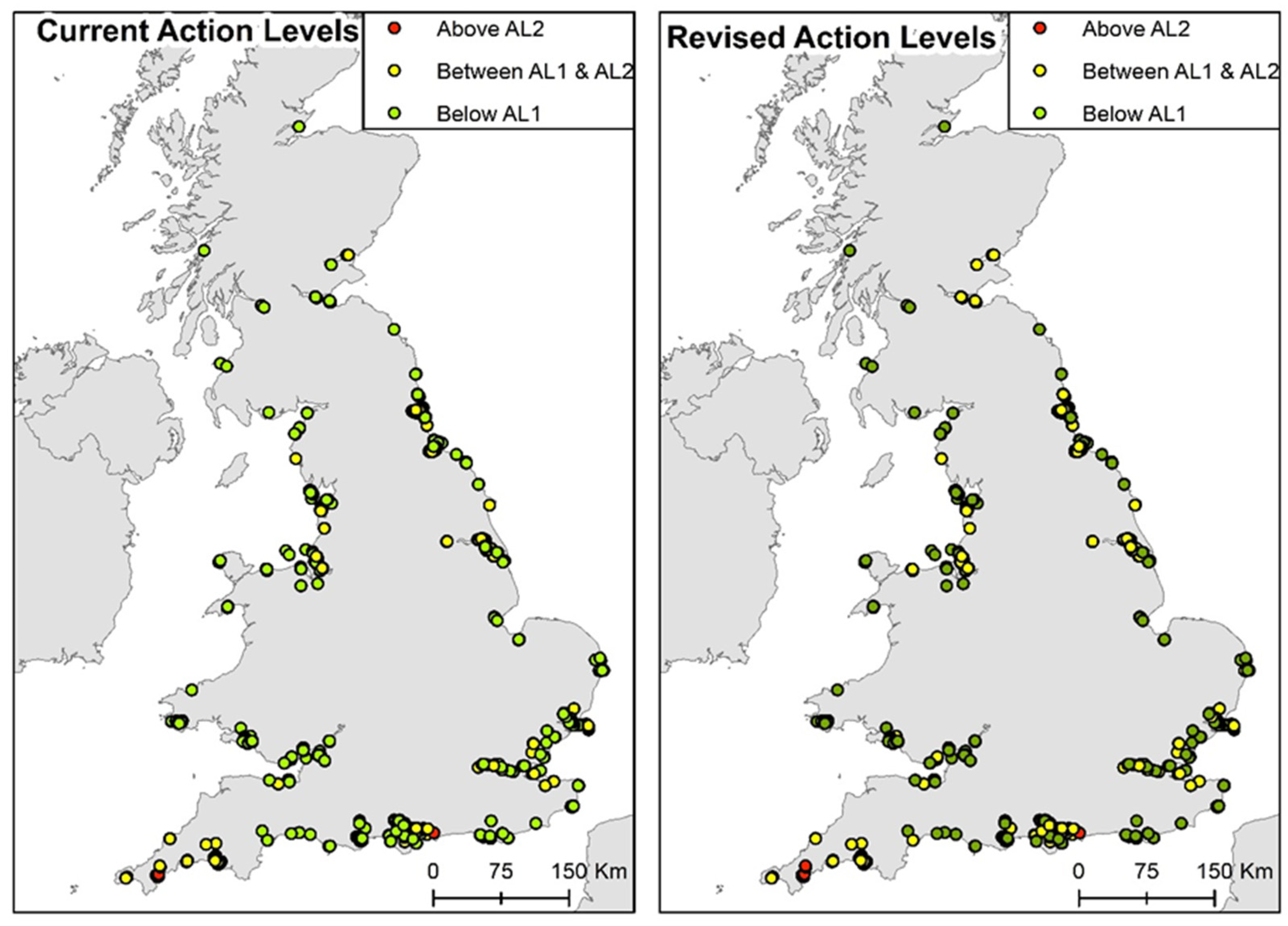
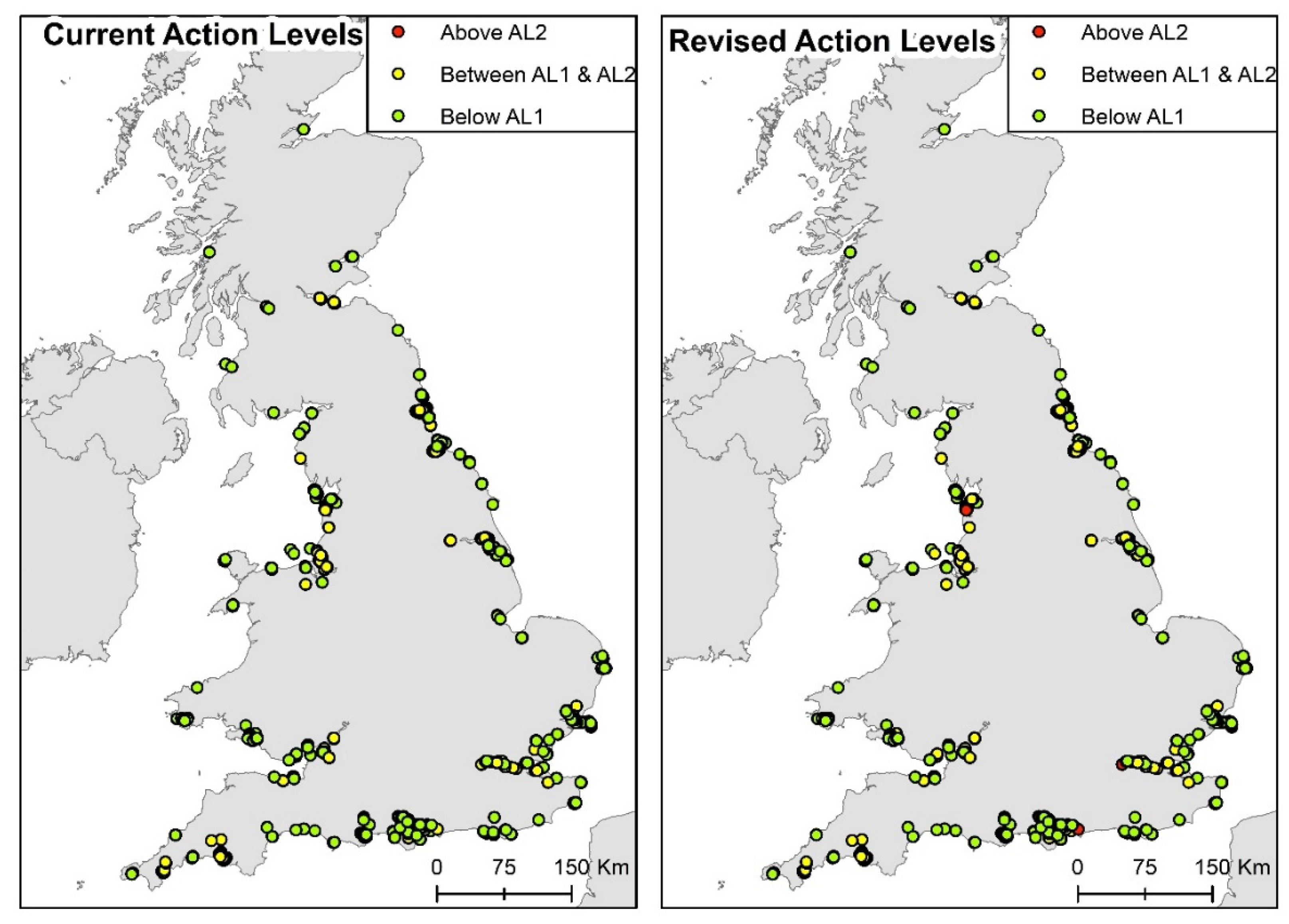
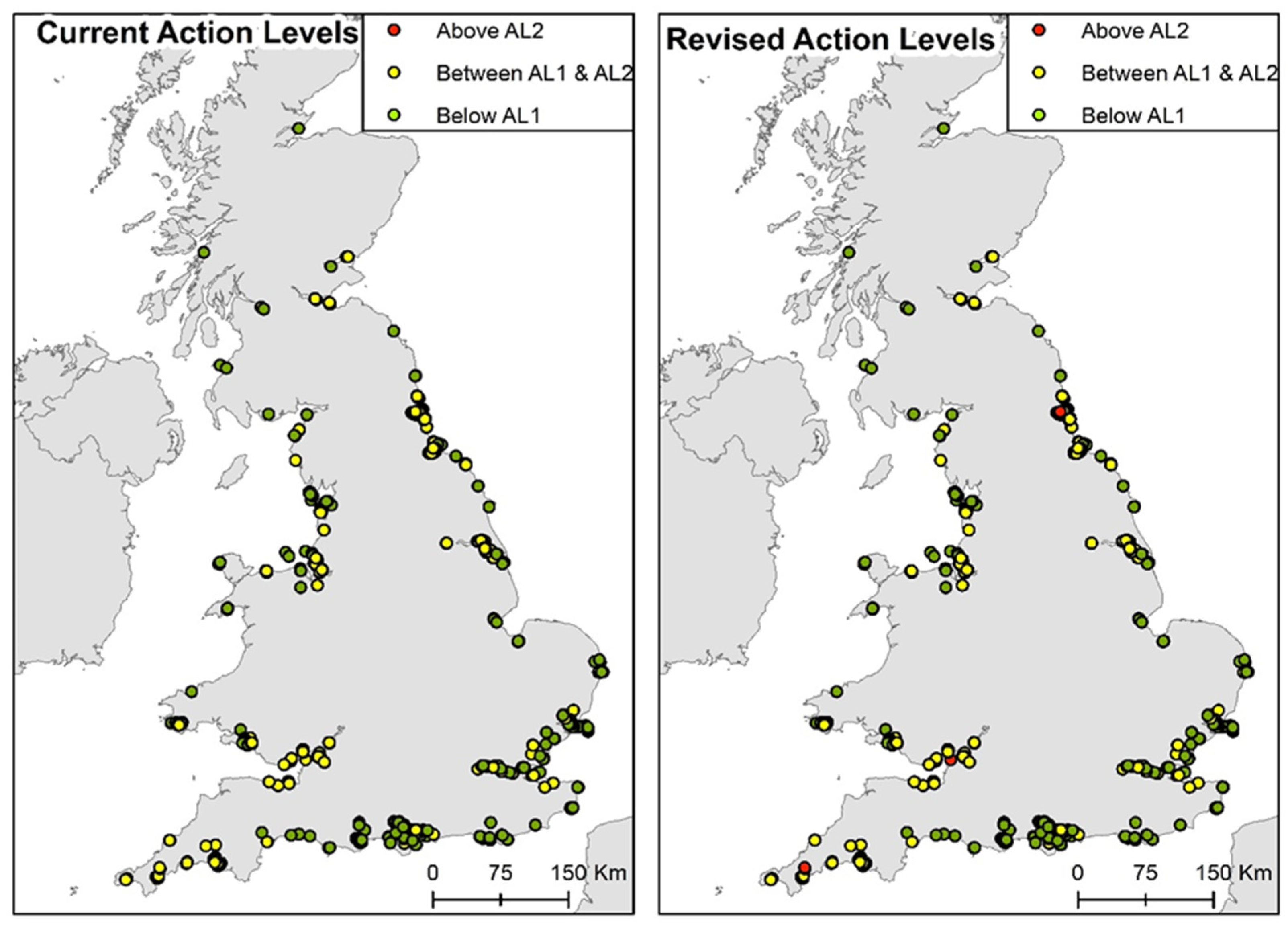
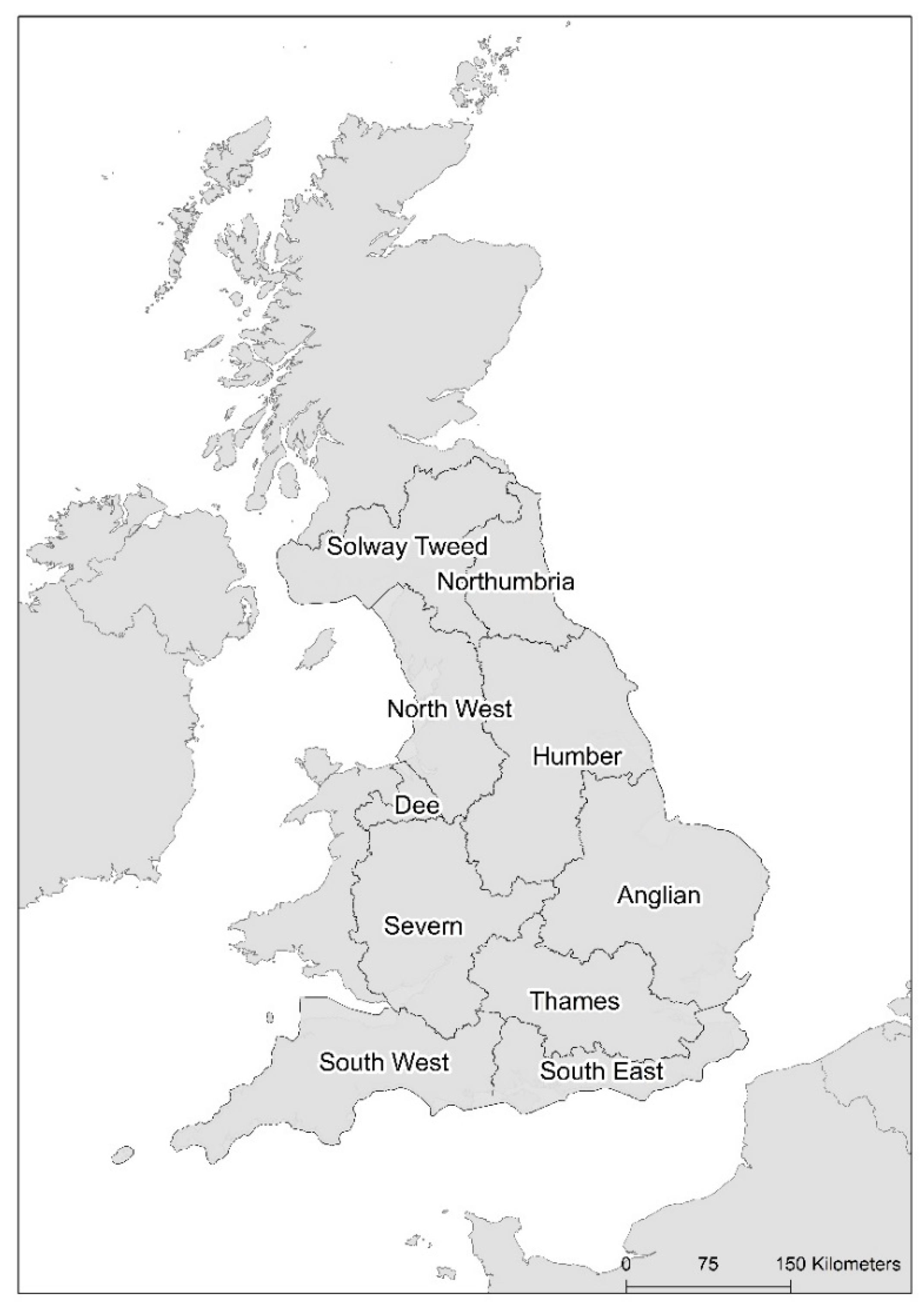
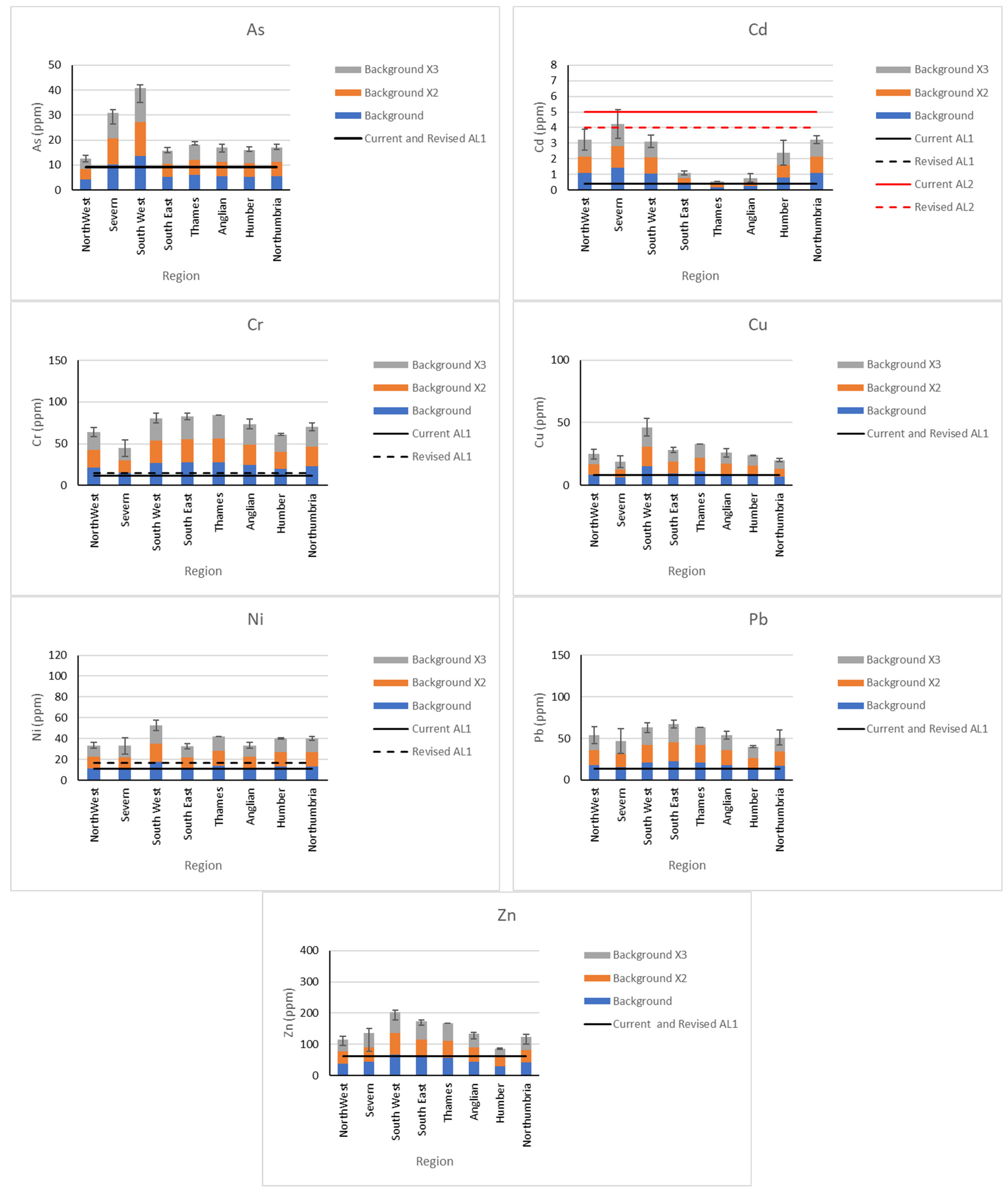
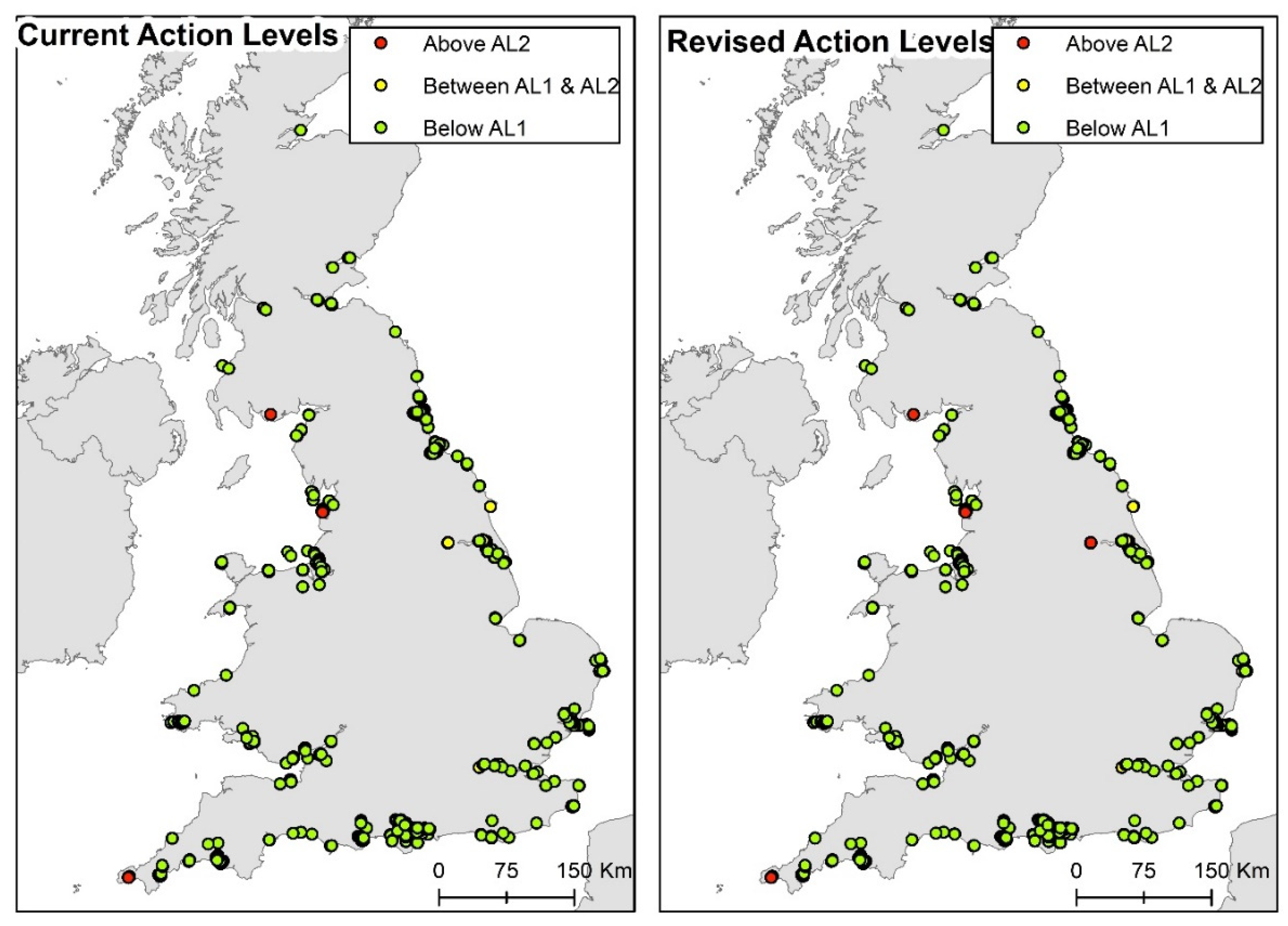
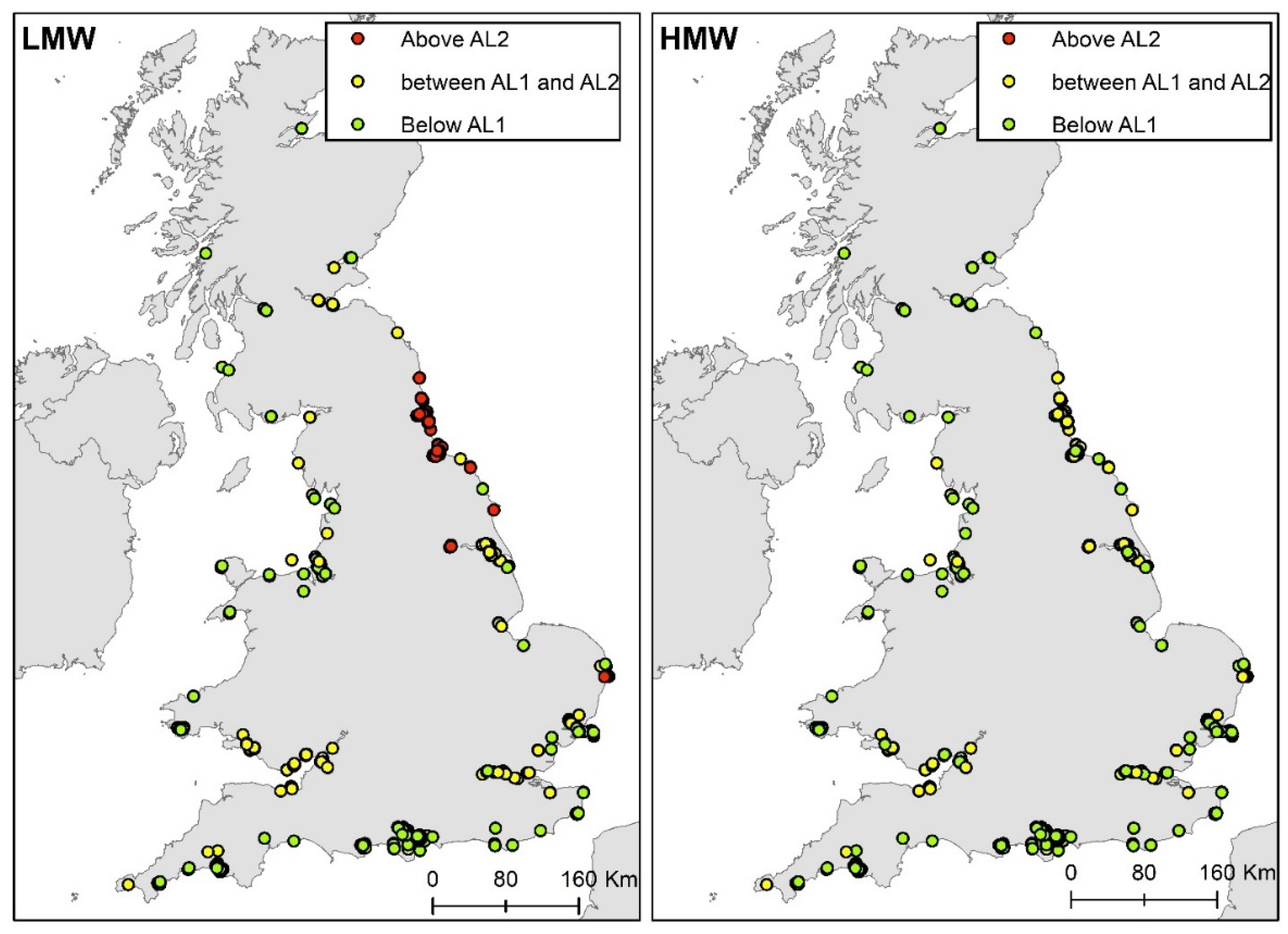
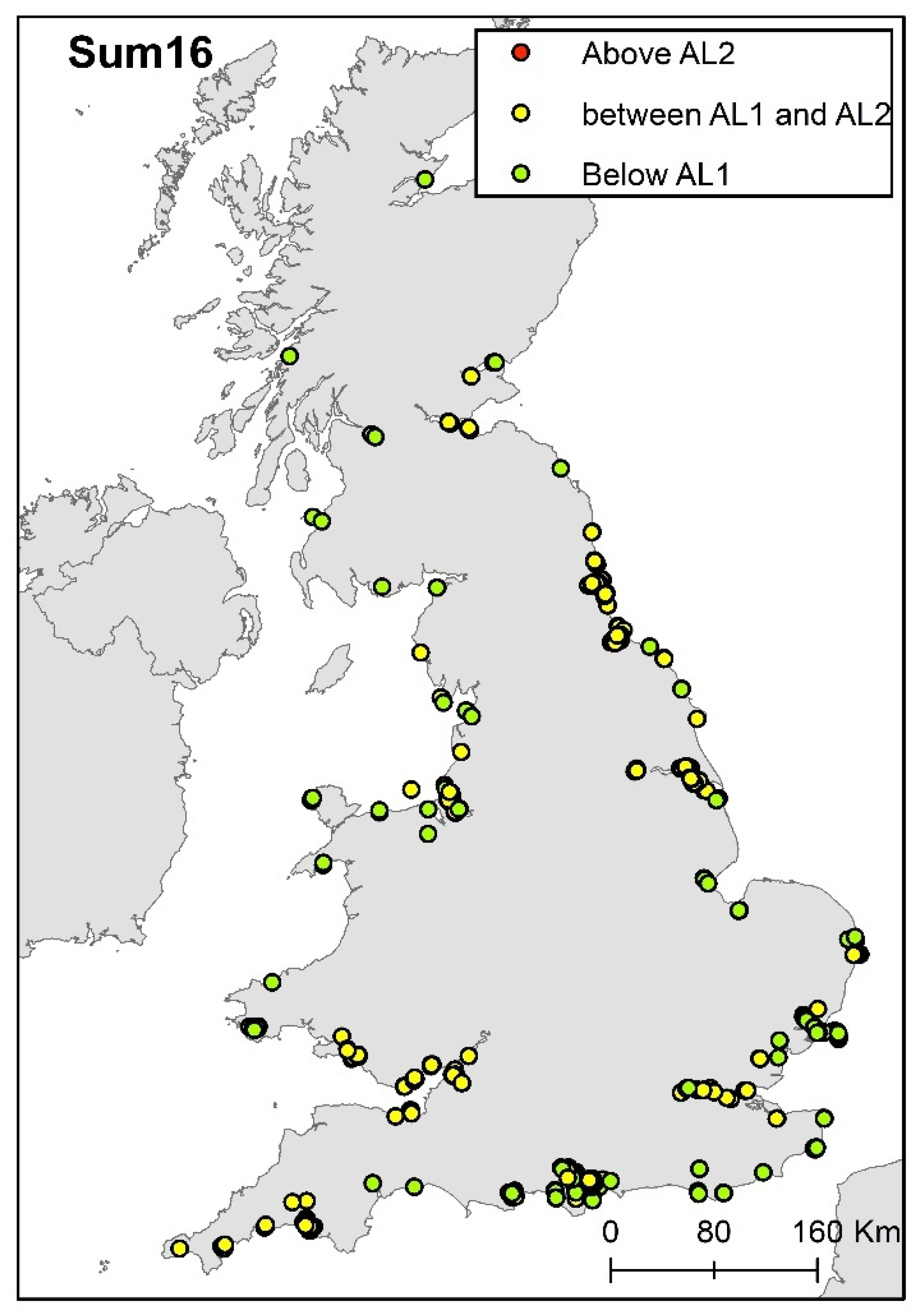
| Contaminant Group | Current ALs | Revised ALs [6] | Scenario 1 | Scenario 2 | Scenario 3 |
|---|---|---|---|---|---|
| Trace metals | Y | Y | Regional AL1s | ||
| Organotins | Y | Y | Proposal 1: Revised AL1 Revised AL2/2 | Proposal 2: Revised AL1/2 Revised AL2/5 | |
| Polycyclic Aromatic Hydrocarbons (PAHs) | N | Y | Individual PAHs: Canadian ISQG AL1 PEL AL2 | Summed PAHs: LMW/HMW ERL AL1 ERM AL2 | Summed PAHs: Σ16PAHs |
| Polychlorinated biphenyls (PCBs) | Y | Y | Individual PCBs: German | Individual PCBs: EACs EAC/3 AL1 EAC AL2 | Summed PCBs: Σ25_PCBs, ΣICES7 German |
| Organochlorine pesticides (OCPs) | Y | N | Individual OCPs: German | ||
| Polybrominated diphenyl ethers (PBDEs) | N | N | Individual BDEs: Canadian FESG/3 AL1 FESG AL2 |
| Metric Descriptor | Range |
|---|---|
| Lower number of samples fall below AL1—more protective | >−10% |
| Slightly lower number of samples fall below AL1 | >−5% to −10% |
| Neutral | <−5% to <5% |
| Slightly higher number of samples fall below AL1 | >5% to 10% |
| Higher number of samples fall below AL1—more permissive | >10% |
| Metric Descriptor | Range |
|---|---|
| Lower number of samples fall above AL2—more permissive | >−10% |
| Slightly lower number of samples fall above AL2 | >−5% to −10% |
| Neutral | <−5% to <5% |
| Slightly higher number of samples fall above AL2 | >5% to 10% |
| Higher number of samples fall above AL2—more protective | >10% |
| Metric Descriptor | Range |
|---|---|
| Range reduced compared with current ALs | − |
| Range unchanged | |
| Range increased compared with current ALs | + |
| Contaminant Group—Units for Current AL1, Current AL2 and Range | Contaminant | Current AL1 | Current AL2 | Range (AL2–AL1) | Sample Number below AL1 (%) | Sample Number above AL1/below AL2 (%) | Sample Number above AL2 (%) | Total Number of Samples |
|---|---|---|---|---|---|---|---|---|
| Trace Metals 1 —ppm | Arsenic (As) | 20 | 100 | 80 | 54 | 45 | 1 | 2719 |
| Cadmium (Cd) | 0.4 | 5 | 4.6 | 66 | 33 | 1 | 2722 | |
| Chromium (Cr) | 40 | 400 | 360 | 45 | 55 | <1 | 2729 | |
| Copper (Cu) | 40 | 400 | 360 | 57 | 42 | 1 | 2734 | |
| Mercury (Hg) | 0.3 | 3 | 2.7 | 65 | 34 | 1 | 2699 | |
| Nickel (Ni) | 20 | 200 | 180 | 25 | 75 | <1 | 2724 | |
| Lead (Pb) | 50 | 500 | 450 | 48 | 51 | 1 | 2731 | |
| Zinc (Zn) | 130 | 800 | 670 | 45 | 52 | 3 | 2733 | |
| Organotins —ppm | Dibutyltin (DBT) | 0.1 | 1 | 0.9 | 97 | 3 | <1 | 2147 |
| Tributyltin (TBT) | 0.1 | 1 | 0.9 | 85 | 13 | 2 | 2234 | |
| Polychlorinated biphenyls (PCBs) —ppb | Σ25_PCBs 2 | 20 | 200 | 180 | 63 | 36 | 1 | 915 |
| ΣICES7 3 | 10 | No AL2 | na 4 | 66 | 34 | na 4 | 1005 | |
| Organo-chlorine pesticides (OCPs) —ppb | Dieldren | 5 | No AL2 | na 4 | 91 | 9 | na 4 | 186 |
| Dichlorodiphenyltrichloroethane (p,p’-DDT) | 1 | No AL2 | na 4 | 63 | 37 | na 4 | 181 |
| Trace Metals 1 | Revised AL1 [7] (ppm) | Difference (ppm) | Difference in Sample Number below AL1 (%) | Revised AL2 [7] (ppm) | Difference (ppm) | Difference in Sample Number above AL2 (%) | Revised Range (ppm) | Difference in Range |
|---|---|---|---|---|---|---|---|---|
| Arsenic (As) | 20 | 0 | 0 | 70 | −30 | 1.5 | 80 | −30 |
| Cadmium (Cd) | 0.4 | 0 | 0 | 4 | −1 | 0.4 | 3.6 | −1 |
| Chromium (Cr) | 50 | 10 | 17.8 | 370 | −30 | 0 | 320 | −40 |
| Copper (Cu) | 30 | −10 | −15.2 | 300 | −100 | 0.5 | 360 | −90 |
| Mercury (Hg) | 0.25 | −0.05 | −7.6 | 1.5 | −1.5 | 2.4 | 1.25 | −1.45 |
| Nickel (Ni) | 30 | 10 | 28.3 | 150 | −50 | 0.1 | 120 | −60 |
| Lead (Pb) | 50 | 0 | 0 | 400 | −100 | 1 | 350 | −100 |
| Zinc (Zn) | 130 | 0 | 0 | 600 | −200 | 2.8 | 470 | −200 |
| Arsenic (As) | Cadmium (Cd) 1 | Chromium (Cr) | Copper (Cu) | Nickel (Ni) | Lead (Pb) | Zinc (Zn) | ||
|---|---|---|---|---|---|---|---|---|
| Current AL1 (ppm) | 20 | 0.40 | 40 | 40 | 20 | 50 | 130 | |
| North West | Regional background (n = 6 except Cd where n = 4) (ppm) | 4 | 1 | 21 | 8 | 11 | 18 | 39 |
| Number of samples below current AL1 (%) | 61 | 56 | 46 | 57 | 33 | 47 | 43 | |
| 1/ regional background (difference (%)) | −56 | 35 | −22 | −37 | −14 | −21 | −26 | |
| 2/ regional background X2 (difference (%)) | −41 | 42 | 1 | −24 | 4 | −8 | −13 | |
| 3/ regional background X3 (difference (%)) | −25 | 44 | 25 | −11 | 33 | 1 | −3 | |
| Total number of samples | 228 | 228 | 230 | 231 | 229 | 230 | 230 | |
| Severn | Regional background (n = 3) (ppm) | 10 | 1 | 15 | 6 | 11 | 16 | 45 |
| Number of samples below current AL1 (%) | 88 | 72 | 17 | 85 | 6 | 7 | 4 | |
| 1/ regional background (difference (%)) | −86 | 28 | −15 | −84 | −5 | −7 | −4 | |
| 2/ regional background X2 (difference (%)) | 4 | 28 | −10 | −81 | −2 | −4 | −1 | |
| 3/ regional background X3 (difference (%)) | 12 | 28 | 7 | −81 | 21 | −3 | 0 | |
| Total number of samples | 118 | 118 | 118 | 118 | 118 | 118 | 118 | |
| South West | Regional background (n = 7) (ppm) | 14 | 1 | 27 | 15 | 18 | 21 | 68 |
| Number of samples below current AL1 (%) | 39 | 57 | 58 | 38 | 31 | 43 | 38 | |
| 1/ regional background (difference (%)) | −18 | 35 | −28 | −22 | −4 | −26 | −20 | |
| 2/ regional background X2 (difference (%)) | 12 | 42 | 26 | −7 | 33 | −7 | 3 | |
| 3/ regional background X3 (difference (%)) | 24 | 43 | 40 | 4 | 64 | 5 | 22 | |
| Total number of samples | 336 | 335 | 338 | 338 | 336 | 338 | 338 | |
| South East | Regional background (n = 8) (ppm) | 5 | 0.37 | 28 | 9 | 11 | 23 | 58 |
| Number of samples below current AL1 (%) | 58 | 91 | 54 | 63 | 39 | 77 | 72 | |
| 1/ regional background (difference (%)) | −56 | −0 | −26 | −59 | −30 | −52 | −55 | |
| 2/ regional background X2 (difference (%)) | −50 | 7 | 29 | −51 | 11 | −6 | −9 | |
| 3/ regional background X3 (difference (%)) | −28 | 7 | 45 | −34 | 54 | 9 | 16 | |
| Total number of samples | 713 | 714 | 714 | 716 | 714 | 715 | 716 | |
| Thames | Regional background (n = 1) (ppm) | 6 | 0.19 | 28 | 11 | 14 | 21 | 56 |
| Number of samples below current AL1 (%) | 75 | 64 | 55 | 66 | 48 | 56 | 63 | |
| 1/ regional background (difference (%)) | −74 | −18 | −12 | −39 | −16 | −25 | −36 | |
| 2/ regional background X2 (difference (%)) | −37 | 0 | 18 | −19 | 25 | −7 | −4 | |
| 3/ regional background X3 (difference (%)) | −4 | 16 | 37 | −6 | 34 | 7 | 13 | |
| Total number of samples | 101 | 102 | 102 | 102 | 102 | 102 | 102 | |
| Anglian | Regional background (n = 5) (ppm) | 6 | 0.26 | 25 | 9 | 11 | 18 | 45 |
| Number of samples below current AL1 (%) | 55 | 89 | 33 | 72 | 19 | 83 | 72 | |
| 1/ regional background (difference (%)) | −43 | −14. | −16 | −59 | −8 | −59 | −58 | |
| 2/ regional background X2 (difference (%)) | −29 | 3 | 21 | −46 | 4 | −37 | −36 | |
| 3/ regional background X3 (difference (%)) | −14 | 8. | 58 | −15 | 42 | 6 | 2 | |
| Total number of samples | 198 | 198 | 199 | 200 | 198 | 200 | 200 | |
| Humber | Regional background (n = 3) (ppm) | 5 | 0.80 | 20 | 8 | 13 | 13 | 29 |
| Number of samples below current AL1 (%) | 32 | 76 | 33 | 63 | 16 | 30 | 100 | |
| 1/ regional background (difference (%)) | −29 | 12 | −17 | −55 | −7 | −23 | −97 | |
| 2/ regional background X2 (difference (%)) | −21 | 18 | 2 | −43 | 9 | −13 | −87 | |
| 3/ regional background X3 (difference (%)) | −11 | 22 | 22 | −32 | 45 | −4 | −79 | |
| Total number of samples | 240 | 240 | 240 | 240 | 240 | 240 | 240 | |
| Northumbria | Regional background (n = 3) (ppm) | 6 | 1.08 | 23 | 7 | 13 | 17 | 41 |
| Number of samples below current AL1 (%) | 37 | 21 | 33 | 30 | 9 | 7 | 10 | |
| 1/ regional background (difference (%)) | −35 | 28 | −25 | −27 | −4 | −5 | −9 | |
| 2/ regional background X2 (difference (%)) | −30 | 56 | 14 | −25 | 10 | −3 | −4 | |
| 3/ regional background X3 (difference (%)) | −9 | 70 | 45 | −21 | 71 | 0 | −0 | |
| Total number of samples | 493 | 495 | 496 | 497 | 495 | 496 | 497 | |
| Organotins | Revised AL1 [7] (ppm) | Difference (ppm) | Difference in Sample Number below AL1 (%) | Revised AL2 [7] (ppm) | Difference (ppm) | Difference in Sample Number above AL2 (%) | Range (Revised) | Difference in Range |
|---|---|---|---|---|---|---|---|---|
| Dibutyltin (DBT) 1 | 0.1 | 0 | 0 | 0.5 | −0.5 | 0.2 | 0.4 | −0.5 |
| Tributyltin (TBT) 1 | 0.1 | 0 | 0 | 0.5 | −0.5 | 2 | 0.4 | −0.5 |
| Proposal 1: Revised AL1, Revised AL2/2 Organotins (ppm) | Proposal 1 AL1 (ppm) | Difference (ppm) | Difference in Sample Number below AL1 (%) | Proposal 1 AL2 (ppm) | Difference (ppm) | Difference in Sample Number above AL2 (%) | Proposal 1 Range (ppm) | Difference in Range |
|---|---|---|---|---|---|---|---|---|
| Dibutyltin (DBT) 1 | 0.1 | 0 | na | 0.25 | −0.75 | 1 | 0.15 | −0.75 |
| Tributyltin (TBT) 1 | 0.1 | 0 | na | 0.25 | −0.75 | 5 | 0.15 | −0.75 |
| Proposal 2: Revised AL1/2, Revised AL2/5 Organotins (ppm) | Proposal 2 AL1 (ppm) | Difference (ppm) | Difference in Sample Number below AL1 (%) | Proposal 2 AL2 (ppm) | Difference (ppm) | Difference in Sample Number above AL2 (%) | Proposal 2 Range (ppm) | Difference in Range |
| Dibutyltin (DBT) 1 | 0.05 | −0.05 | −5 | 0.1 | −0.9 | 3 | 0.05 | −0.85 |
| Tributyltin (TBT) 1 | 0.05 | −0.05 | −10 | 0.1 | −0.9 | 13 | 0.05 | −0.85 |
| Polycyclic Aromatic Hydrocarbons (PAHs) | Revised AL1 [7] (ppb) | Number of Samples below AL1 (%) | Number of Samples below AL1 (%)—NE Excluded | Total Number of Samples | Total Number of Samples—NE Excluded | |
|---|---|---|---|---|---|---|
| Abbreviation | Full Name | |||||
| Acenapth | Acenaphthene | 100 | 89 | 95 | 1861 | 1328 |
| Acenapthylene | Acenaphthylene | 100 | 75 | 88 | 1870 | 1335 |
| Anthracn | Anthracene | 100 | 51 | 66 | 1869 | 1334 |
| BAA | Benz(a)anthracene | 100 | 30 | 38 | 1865 | 1330 |
| BAP | Benzo(a)pyrene | 100 | 27 | 34 | 1872 | 1337 |
| BBF | Benzo(b)fluoranthene | 100 | 22 | 27 | 1873 | 1338 |
| BEP | Benzo(e)pyrene | 100 | 30 | 38 | 1850 | 1316 |
| Benzghip | Benzo(g,h,i)perylene | 100 | 30 | 37 | 1872 | 1337 |
| BKF | Benzo(k)fluoranthene | 100 | 37 | 46 | 1865 | 1330 |
| C1N | Methyl Naphthalenes | 100 | 37 | 52 | 1807 | 1273 |
| C1PHEN | Methyl Phenanthrenes/Anthracenes | 100 | 22 | 31 | 1806 | 1273 |
| C2N | Dimethyl Naphthalenes | 100 | 27 | 38 | 1804 | 1271 |
| C3N | Trimethyl Naphthalenes | 100 | 20 | 27 | 1802 | 1270 |
| Chrysene | Chrysene | 100 | 34 | 43 | 1860 | 1328 |
| Debenzah | Dibenz[a,h]anthracene | 100 | 17 | 21 | 1860 | 1328 |
| Flurant | Fluoranthene | 100 | 19 | 23 | 1865 | 1333 |
| Fluorene | Fluorene | 100 | 59 | 76 | 1860 | 1329 |
| Indypr | Indeno(1,2,3-cd)pyrene | 100 | 27 | 33 | 1860 | 1329 |
| Napth | Naphthalene | 100 | 48 | 64 | 1862 | 1331 |
| Perylene | Perylene | 100 | 36 | 44 | 1842 | 1311 |
| Phenant | Phenanthrene | 100 | 30 | 40 | 1861 | 1330 |
| Pyrene | Pyrene | 100 | 18 | 22 | 1860 | 1329 |
| THC | Total Hydrocarbons | 100 (ppm) | 15 | 80 | 2048 | 1429 |
| Polycyclic Aromatic Hydrocarbons (PAHs) —Abbreviation 1 | ISQG [13] AL1 (ppb) | Number of Samples below AL1 (%) | Number of Samples below AL1 (%)—NE Excluded | PEL [13] AL2 (ppb) | Number of Samples above AL2 (%) | Number of Samples above AL2 (%)—NE Excluded |
|---|---|---|---|---|---|---|
| Acenapth | 7 | 31 | 38 | 89 | 12 | 6 |
| Acenapthylene | 6 | 21 | 27 | 128 | 21 | 9 |
| Anthracn | 47 | 38 | 49 | 245 | 25 | 12 |
| BAA | 75 | 24 | 30 | 693 | 23 | 12 |
| BAP | 89 | 24 | 30 | 763 | 21 | 14 |
| Chrysene | 108 | 35 | 44 | 846 | 12 | 8 |
| Debenzah | 6 | 14 | 18 | 135 | 23 | 12 |
| Flurant | 113 | 20 | 25 | 1494 | 19 | 11 |
| Fluorene | 21 | 31 | 42 | 144 | 31 | 14 |
| Napth | 35 | 31 | 42 | 391 | 27 | 6 |
| Phenant | 87 | 27 | 37 | 544 | 34 | 15 |
| Pyrene | 153 | 26 | 32 | 1398 | 19 | 11 |
| Polycyclic Aromatic Hydrocarbons (PAHs) | ERL [15] AL1 (ppb) | Number of Samples below AL1 (%) | Number of Samples below AL1 (%)—NE Excluded | ERM [15] AL2 (ppb) | Number of Samples above AL2 (%) | Number of Samples above AL2 (%)—NE Excluded | Total Number of Samples | Total Number of Samples—NEExcluded |
|---|---|---|---|---|---|---|---|---|
| LMW 1 | 552 | 40 | 54 | 3160 | 24 | 6 | 1874 | 1339 |
| HMW 2 | 1700 | 47 | 60 | 9600 | 8 | 6 | 1875 | 1340 |
| Polycyclic Aromatic Hydrocarbons (PAHs) | Proposed AL1 (ppb) | Number of Samples below AL1 (%) | Number of Samples below AL1 (%)—NE Excluded | Proposed AL2 (ppb) | Number of Samples above AL2 (%) | Number of Samples above AL2 (%)—NE Excluded | Total Number of Samples | Total Number of Samples—NE Excluded |
|---|---|---|---|---|---|---|---|---|
| Σ16PAH 1 [17] | 2000 | 37 | 47 | 45,000 | 2 | 1 | 1876 | 1341 |
| Polychlorinated Biphenyls (PCBs) | Revised AL1 [7] (ppm) | Difference (ppb) | Difference in Sample Number below AL1 (%) | Revised AL2 [7] (ppb) | Difference (ppb) | Difference in Sample Number above AL2 (%) | Range (Revised) (ppb) | Difference in Range |
|---|---|---|---|---|---|---|---|---|
| Σ25_PCBs 1 | 20 | 0 | 0 | 180 | −20 | −20 | 160 | −20 |
| Polychlorinated Biphenyls (PCBs) | OSPAR Overview German [8] AL1 (ppb) | Number of Samples below AL1 (%) | OSPAR Overview German [8] AL2 (ppb) | Number of Samples above AL2 (%) | OSPAR Overview German [8] Range (ppb) | Total Number of Samples |
|---|---|---|---|---|---|---|
| PCB101 | 2 | 72 | 6 | 7 | 4 | 992 |
| PCB118 | 3 | 85 | 10 | 3 | 7 | 995 |
| PCB138 | 4 | 83 | 12 | 3 | 8 | 963 |
| PCB153 | 5 | 89 | 15 | 2 | 10 | 990 |
| PCB180 | 2 | 80 | 6 | 5 | 4 | 989 |
| PCB28 | 2 | 81 | 6 | 6 | 4 | 984 |
| PCB52 | 1 | 62 | 3 | 11 | 2 | 985 |
| Polychlorinated Biphenyls (PCBs) | EAC/3 [17] AL1 (ppb) | Number of Samples below AL1 (%) | EAC [18] AL2 (ppb) | Number of Samples above AL2 (%) | EAC Range (ppb) | Total Number of Samples |
|---|---|---|---|---|---|---|
| PCB101 | 1 | 53 | 3 | 18 | 2 | 992 |
| PCB118 | 0.2 | 3 | 0.6 | 55 | 0.4 | 995 |
| PCB138 | 2.6 | 76 | 7.9 | 6 | 5.3 | 963 |
| PCB153 | 13 | 97 | 40 | 1 | 27 | 990 |
| PCB180 | 4 | 91 | 12 | 1 | 8 | 989 |
| PCB28 | 0.6 | 57 | 1.7 | 23 | 1.1 | 984 |
| PCB52 | 0.9 | 59 | 2.7 | 12 | 1.8 | 985 |
| Polychlorinated Biphenyls (PCBs) | Proposed AL1 (ppm) | Difference (ppb) | Difference in Sample Number below AL1 (%) | Proposed AL2 (ppb) | Difference (ppb) | Difference (Σ25_PCBs1) or Number of Samples (ΣICES71) above AL2 (%) | Range (ppb) | Difference in Range | |
|---|---|---|---|---|---|---|---|---|---|
| Proposal 1 OSPAR Overview German [8] | Σ25_PCBs 1 | 40 | 20 | 17 | 120 | −80 | 2 | 80 | −100 |
| ΣICES7 1 | 20 | 10 | 16 | 60 | na | 4 | 40 | na | |
| Proposal 2: 1/2 Revised [7] as for Σ25_PCBs 1 | ΣICES7 1AL2 | 10 | 0 | 0 | 90 | na | 2 | 80 | na |
| Organochlorine Pesticides (OCPs) | OSPAR Overview German [8] AL1 (ppb) | Number of Samples below AL1 (%) | OSPAR Overview German [8] AL2 (ppb) | Number of Samples above AL2 (%) | Total Number of Samples | |
|---|---|---|---|---|---|---|
| Abbreviation | Name | |||||
| AHCH | alpha-Hexachlorocyclohexane (α-HCH) | 0.4 | 88 | 1 | 3 | 167 |
| GHCH | gamma-Hexachlorocyclohexane (γ-HCH) (also known as lindane) | 0.2 | 0 | 0.6 | 5 | 167 |
| HCB | Hexachlorobenzene | 2 | 92 | 6 | 1 | 435 |
| DDE | Dichlorodiphenyldichloroethylene (p,p’-DDE) | 1 | 57 | 3 | 11 | 479 |
| DDT 1 | Dichlorodiphenyltrichloroethane (p,p’-DDT) 1 | 1 | 0 1 | 3 | 18 | 181 |
| TDE | dichlorodiphenyldichloroethane (p,p’-TDE) (also known as DDD) | 3 | 58 | 10 | 21 | 185 |
| Polybrominated Diphenyl Ethers (PBDEs) | FESG/3 [19] AL1 (ppb) | Number of Samples below AL1 (%) | FESG [19] AL2 (ppb) | Number of Samples above AL2 (%) | Total Number of Samples |
|---|---|---|---|---|---|
| BDE100 | 0.3 | 44 | 1 | 14 | 141 |
| BDE153 | 367 | 100 | 1100 | 0 | 141 |
| BDE154 | 367 | 100 | 1100 | 0 | 141 |
| BDE183 | 4666 | 100 | 14,000 | 0 | 141 |
| BDE209 | 16 | n | 47.5 | n | 0 |
| BDE28 | 37 | 100 | 110 | 0 | 141 |
| BDE47 | 33 | 100 | 97.5 | 0 | 141 |
| BDE66 | 33 | 100 | 97.5 | 0 | 133 |
| BDE85 | 0.3 | 77 | 1 | 2 | 133 |
| BDE99 | 0.3 | 23 | 1 | 61 | 133 |
| Contaminant Group—Units | Contaminant | Current AL1 | Proposed AL1 | Current AL2 | Proposed AL2 |
|---|---|---|---|---|---|
| Trace Metals –ppm | Arsenic (As) | 20 | 20 | 100 | 70 |
| Cadmium (Cd) | 0.4 | 0.4 | 5 | 4 | |
| Chromium (Cr) | 40 | 50 | 400 | 370 | |
| Copper (Cu) | 40 | 30 | 400 | 300 | |
| Mercury (Hg) | 0.3 | 0.25 | 3 | 1.5 | |
| Nickel (Ni) | 20 | 30 | 200 | 150 | |
| Lead (Pb) | 50 | 50 | 500 | 400 | |
| Zinc (Zn) | 130 | 130 | 800 | 600 | |
| Organotins —ppm | Dibutyltin (DBT) | 0.1 | 0.1 | 1 | 0.5 |
| Tributyltin (TBT) | 0.1 | 0.1 | 1 | 0.5 | |
| Polycyclic Aromatic Hydrocarbons (PAHs) —ppb | LMW 1 | 552 | 3160 | ||
| HMW 1 | 1700 | 9600 | |||
| Polychlorinated biphenyls (PCBs) —ppb | Σ25_PCBs 2 | 20 | 20 | 200 | 180 |
| ΣICES7_PCBs 2 | 10 | 10 | 90 | ||
| PCB28 | 0.6 | 1.7 | |||
| PCB52 | 0.9 | 2.7 | |||
| PCB101 | 1 | 3 | |||
| PCB118 | 0.2 | 0.6 | |||
| PCB138 | 2.6 | 7.9 | |||
| PCB153 | 13 | 40 | |||
| PCB180 | 4 | 12 | |||
| Organo-chlorine pesticides (OCPs) —ppb | Dichlorodiphenyltrichloroethane (p,p’-DDT) | 1 | 1 | ||
| Dieldren | 5 | 5 | |||
| Polybrominated diphenyl ethers (PBDEs) —ppb | BDE28 | 38 | 110 | ||
| BDE47 | 33 | 97.5 | |||
| BDE66 | 33 | 97.5 | |||
| BDE85 | 0.3 | 1 | |||
| BDE99 | 0.3 | 1 | |||
| BDE100 | 0.3 | 1 | |||
| BDE153 | 367 | 1100 | |||
| BDE154 | 367 | 1100 | |||
| BDE183 | 4666 | 14,000 | |||
| BDE209 | 16 | 47.5 |
Publisher’s Note: MDPI stays neutral with regard to jurisdictional claims in published maps and institutional affiliations. |
© 2021 by the authors. Licensee MDPI, Basel, Switzerland. This article is an open access article distributed under the terms and conditions of the Creative Commons Attribution (CC BY) license (https://creativecommons.org/licenses/by/4.0/).
Share and Cite
Mason, C.; Vivian, C.; Griffith, A.; Warford, L.; Hynes, C.; Barber, J.; Sheahan, D.; Bersuder, P.; Bakir, A.; Lonsdale, J.-A. Reviewing the UK’s Action Levels for the Management of Dredged Material. Geosciences 2022, 12, 3. https://doi.org/10.3390/geosciences12010003
Mason C, Vivian C, Griffith A, Warford L, Hynes C, Barber J, Sheahan D, Bersuder P, Bakir A, Lonsdale J-A. Reviewing the UK’s Action Levels for the Management of Dredged Material. Geosciences. 2022; 12(1):3. https://doi.org/10.3390/geosciences12010003
Chicago/Turabian StyleMason, Claire, Chris Vivian, Andrew Griffith, Lee Warford, Clare Hynes, Jon Barber, David Sheahan, Philippe Bersuder, Adil Bakir, and Jemma-Anne Lonsdale. 2022. "Reviewing the UK’s Action Levels for the Management of Dredged Material" Geosciences 12, no. 1: 3. https://doi.org/10.3390/geosciences12010003
APA StyleMason, C., Vivian, C., Griffith, A., Warford, L., Hynes, C., Barber, J., Sheahan, D., Bersuder, P., Bakir, A., & Lonsdale, J.-A. (2022). Reviewing the UK’s Action Levels for the Management of Dredged Material. Geosciences, 12(1), 3. https://doi.org/10.3390/geosciences12010003







